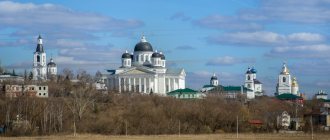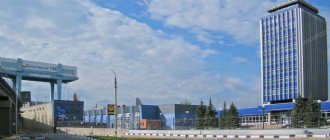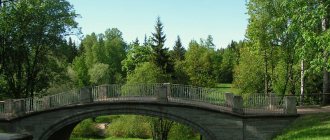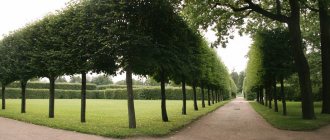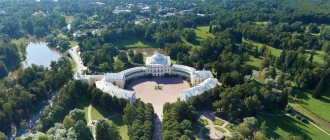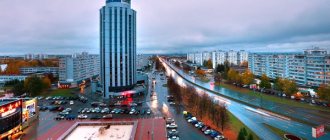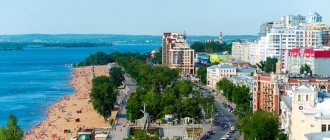A few facts about the city of Lomonosov
- The city was founded in 1710, until 1948 it was called Oranienbaum.
- Lomonosov is located on the shore of the Gulf of Finland, opposite Kronstadt. The cities are connected by the Ring Road, the distance between them is approximately 20 km.
- Near the city there are suburbs: Peterhof and Strelna.
- The population of Lomonosov is about 43 thousand people.
The most significant military events associated with the city
In the fall of 1941, the Nazi army reached the closest approaches to Leningrad - the Nazis stood at the Pulkovo Heights. The fascist German command aimed to create a threat to Kronstadt, the base of the Baltic Fleet, by capturing the forts Krasnaya Gorka and Gray Horse.
Each line in the coastal direction was steadfastly defended by units of the 8th Army under the command of General V.I. Shcherbakova. By September 7, 1941, with the active support of the 2nd and 5th Marine Brigades, coastal and naval artillery and naval aviation, they secured a foothold at the Voronka River - Bolshoye Gorlovo line, preventing the enemy from reaching the coastal forts and Kronstadt.
By September 15, the enemy's advanced detachments still managed to reach the Gulf of Finland in the area between the villages of Volodarsky and Uritsk, cutting off the troops of the 8th Army from the main forces of the Leningrad Front.
This is how the Primorsky bridgehead was formed, or, as it was called for its small size, the Oranienbaum “patch” - a land scorched by fire, dissected by shell fragments, stretching for more than 50 kilometers along the shore of the Gulf of Finland, from Peterhof in the east to the Voronka River in the west.
What did the Nazis do to destroy the “patch”! Furious air bombing, daily artillery shelling, massive attacks by tanks and infantry... But in vain.
On November 2, the command of the Leningrad Front formed the Primorsky Operational Group of Forces on the bridgehead, which included the 48th Infantry Division, the 2nd and 5th Brigades and the 3rd Special Rifle Regiment of the Marine Corps. Major General A.N. became the commander of the group of troops. Astanin, member of the Military Council - brigade commissar V.P. Mzhavanadze.
In the winter of 1941/42, the bridgehead was defended by 27 thousand people. The soldiers had to be in the trenches almost around the clock, sleeping three to four hours a day.
In continuous battles, the defenders of the Oranienbaum “patch” exhausted and bled the fascist divisions surrounding them.
In those days, the legendary cruiser Aurora stood in one of the bays of the Oranienbaum port. The six-inch guns removed from it crushed the enemy at the Duderhof Heights. The cruiser's crew fought on land.
Soon after the blockade of Leningrad was broken, preparations began for battles for the complete liberation of the Leningrad region from the Nazi invaders. Already in November 1943, sailors of the Red Banner Baltic Fleet secretly delivered the 2nd Shock Army, commanded by Lieutenant General I.I., to the Primorsky bridgehead. Fedyuninsky.
Hitler's command did not notice the concentration of an entire army on the Primorsky bridgehead. Our troops had a significant superiority over the enemy in the number of artillery barrels, light and heavy machine guns, anti-tank rifles and tanks. The command of the Leningrad Front used the bridgehead as a kind of springboard from which the offensive of the 2nd Shock Army began the heroic epic of defeating the troops besieging Leningrad.
At 9:25 a.m. on January 14, 1944, salvos of Katyusha rockets were heard in the breakthrough area of the 2nd Shock Army. More than 104 thousand shells from the forts Krasnaya Gorka and Gray Horse and from the ships of Kronstadt fell on the enemy fortifications in 65 minutes. Then the soldiers of the 2nd Shock Army rose from the trenches and rushed towards the enemy in an unstoppable avalanche.
And the next day, at 9 o’clock in the morning, the soldiers fighting at Oranienbaum heard cannonade coming from the direction of Leningrad. It was from the Pulkovo area that the troops of the 42nd Army went on the offensive. The two armies of the front, having delivered a double blow to the enemy - from the Oranienbaum bridgehead and the Pulkovo Heights, met in the area of Russko-Vysotskoye and Ropsha, encircling and defeating the Strelny-Peterhof enemy group.
The Nazi invaders fiercely resisted, but our troops actively developed the offensive and, as a result of 12 days of fierce fighting, broke through the heavily fortified, deeply echeloned, long-term defense of the gate, throwing it back 65-100 kilometers from Leningrad.
On January 27, 1944, 24 salvoes from 324 guns thundered over the Neva. Leningrad solemnly celebrated the complete lifting of the enemy blockade.
...Oranienbaum unconquered bridgehead. This narrow strip of land along the coast of the Gulf of Finland was defended from the enemy by Soviet soldiers - infantrymen and sailors of the Baltic, about whose valor and heroism many books have been written; Their feat is immortalized by monuments erected at the battle sites.
From the history of the city
The glorious biography of Lomonosov began in 1710, when construction of the estate of Alexander Danilovich Menshikov began in the vicinity of the current city. A small settlement quickly formed next to the luxurious palace, and a large park was laid out under the windows, and a canal was soon dug.
Since 1783, Lomonosov became a district town within the St. Petersburg province. The main treasury was located in it, and already the next year Lomonosov began to be built up according to “model projects”. The number of residents gradually grew, and less than a century later, a developed infrastructure, many shops and military units appeared on the Oranienbaum base.
During the reign of Catherine II, a new residence was built in Lomonosov: the Own Dacha. As well as many other elements of the entire complex: the Chinese Palace, the Rolling Hill, the Maid of Honor and even the Cavalry Complex. Next to the palace, the Upper Park, rich in original flora, was recreated with a regular garden and a landscape complex that was fashionable at that time.
By 1917, the number of townspeople had increased to 7 thousand, and Lomonosov was considered the country residence of the imperial couple. After the change of power during the revolution, much changed in the way of life of the old city. The usual street names disappeared, the palaces of eminent nobles turned into museums... The former Oranienbaum experienced particular suffering during the Siege. Fierce fighting took place near the city. But due to the desperate defense of Soviet soldiers, Lomonosov was not surrendered to the enemy. Therefore, many of the city’s historical heritage sites have been preserved.
And a century later, more than 43 thousand Russians live in Lomonosov. Nowadays, many cultural events are held in the “City of Military Glory,” and ancient palace complexes and parks are being actively restored. What sights of Lomonosov can you see now? Let's look at their features, operating mode and cost.
Oranienbaum – how to get there from St. Petersburg
Since Lomonosov is located only 50 km from St. Petersburg, getting to it is as easy as pie. The most popular option is by train from the Baltic Station. Electric trains go to the Oranienbaum I station and arrive at the final station in about an hour.
You can also get to Lomonosov by minibus from the Avtovo metro station (if you go from the Baltic Station, there is a chance of being stuck in traffic jams for a long time), the minibuses are located on the opposite side of the metro entrance. Departures occur every 10-15 minutes, travel time takes about an hour. From the Baltic Station to Lomonosov there are minibuses No. 054 and No. 404a, from the Avtovo metro station there are minibuses No. 300, 424a, 404 and bus No. 200 (the bus makes many stops around the city, so the travel time will take more than an hour). In addition, minibus No. 343 runs from the Prospekt Veteranov metro station to Lomonosov.
If you plan to get to Lomonosov by car, you should get from the Moskovsky district of St. Petersburg to the A-118 highway and then move along it. In the Petropavlovsk district you will need to turn onto Oranienbaumsky Prospekt, from where it’s already a stone’s throw to Lomonosov. Due to possible traffic jams, travel time may also extend by an hour.
Things to do
- Tripster - craft beer tours from locals.
- Sputnik and Wheatlas - excursions from professional guides.
Sights of Lomonosov
Oranienbaum Park
Oranienbaum is called the standard of landscape gardening art during the reign of the Romanovs. Its area exceeds 160 hectares, so it will take you a lot of time to walk around the entire park. The park is of particular historical and cultural value, since the periods of creation of new parts occurred in different historical periods.
The park's relief was created almost artificially. In Peter's times, forests were cleared and canals were laid. The park is crossed by the Karasta River, and the boundaries of the park are outlined by numerous alleys.
Great Menshikov Palace
The Grand Palace is considered the oldest building in Oranienbaum and in all of Lomonosov. It was with him that the biography of the city began. It is located on the very coast of the Baltic Sea. Thanks to the talents of the architects Schedel, Fontana and Braunstein, it seems as if it is directed towards the water.
The center of the palace is a two-story building with an exotic prince's crown on the roof. Next to it are round and spacious pavilions, and under the windows, in the times of Peter the Great, a garden with exquisite fountains and statues was laid out. Previously, visitors arrived at the Menshikov Palace through the sea canal.
The peculiarity of this architectural monument of the 18th century is that it has not been restored. Therefore, you should definitely see a true masterpiece of Russian architecture.
Chinese Palace
This majestic building is located in the southeast of Oranienbaum. Of all the buildings of the palace and park complex, it is the Chinese Palace of the architect Rinaldi that is a Rococo masterpiece. The palace was not captured by the Nazis during the war, so it was preserved almost in its original form.
Of course, the structure of the late 18th century needs restoration in any case. Therefore, it was carried out in 2011. Nowadays, the Grand Annex and the Hall of Muses, the unique Glass Bead Cabinet of Catherine II and the Blue Living Room are open to visitors.
Palace of Peter III
In the southwest of Oranienbaum is the palace of another Russian ruler - Peter III. It was also created by Rinaldi; immediately after construction was completed, the palace of Peter III became the center of the amusing fortress of Peterstadt.
Nowadays, this miniature palace is viewed from special earthen ramparts during excursions. A neat garden in the spirit of the 18th century has been formed around the palace of Peter III, and inside it there are exhibitions with household items. In the palace you can also see a number of exhibits from other museum complexes in St. Petersburg and Lomonosov. They were taken here during the hostilities of 1941-1945.
Museum-Pavilion Stone Hall
The Stone Hall is the name given to the pavilion in Oranienbaum Park. The name of its architect is shrouded in mystery, and the structure itself changed its name more than once: the New Palace, and then the Masquerade, Dance... Initially, concerts and holidays were held there, which is not difficult to understand from the names. In 1843, the pavilion was converted into the Lutheran Chapel of St. Helena, but after some time the Stone Hall was restored to its original Elizabethan Baroque charm.
Currently, the pavilion houses an interactive cinema and an exhibition of Oranienbaum statues. In the summer, classical concerts are held at the Stone Hall.
Lomonosov Museum of Local Lore
Address: st. Eleninskaya, house 25
The collection of the Lomonosov Museum of Local Lore exceeds 15,000 exhibits. Among them there are things of famous families: the Filatovs, the Bianchis, the Stravinskys, as well as many other symbols of the rich history of Lomonosov. These are the fruits of archaeological excavations in Koporye, ancient coins and utensils, photographs and artifacts from the Great Patriotic War, evidence of the special culture of the Ingrian Finns.
This free museum frequently changes exhibitions and offers its visitors tourist and excursion support.
Cathedral of the Archangel Michael
The history of the cathedral began with the appearance of a wooden church in 1865. It was created with donations from private donors. For a long time it was assigned to the palace Panteleimon Church, but eventually achieved sovereignty. During the Soviet period, the previously thriving cathedral was turned into a food warehouse. But already in 1988, work began on the revival of the cathedral itself and the adjacent bell tower.
The Neo-Russian Cathedral holds daily services and conducts regular religious processions. Its interior decoration is distinguished by its color, which was recreated by talented artists and woodcarvers in the 21st century.
Temple of St. Spyridon of Trimifuntsky
The first cathedral in honor of Spyridon of Trimifuntsky was built back in the 19th century; many trials befell the Orthodox shrine. Especially during the Soviet period. The revival of the temple began only in 2002 thanks to the efforts of Archpriest Oleg Emelianenko. Nowadays services are held there.
The temple houses a number of valuable icons brought from Greece and Jerusalem, as well as shrines - things of St. Spyridon. Several times a week special prayers are held with these relics, and if you are lucky, you will be able to see the extraordinary Orthodox sights of Lomonosov.
Memorial complex Malaya Piskarevka
Malaya Piskarevka appeared in the city back in 1973 and still retains the status of the largest military burial ground in the area. The memorial in honor of the tragic events of the Second World War is located on Krasnoflotskoye Highway, next to the railway tracks. In a small square, the dead townspeople and fearless defenders of the Oranienbaum bridgehead are buried in three mass graves. In total, about 5,000 people are buried here.
Not far from the memorial complex there are the Holy Trinity Cemetery and the church of the same name, a monument to the Little Road of Life and memorial granite fenced with metal chains.
Museum of the Polar Marine Exploration Expedition
The Museum of the History of the Expedition (as it is popularly called) is located on Pobeda Street. Its exhibition tells about Arctic research. The museum has two halls: the World Ocean and the Arctic. It is not difficult to guess what the display windows of each room are dedicated to.
Next to the museum there is a small park with unusual stone sculptures dedicated to the fauna of the Arctic and scientific work in the north. This is not the most spectacular green area where there are Lomonosov attractions. But why not get acquainted with modern landscape design if you find yourself in this distinctive city?
Palace and park ensemble "Oranienbaum"
Address: Dvortsovy Ave., 48 Phone: Website: peterhofmuseum.ru Opening hours: park: 9.00-20.00, palaces: 11.00-17.00, Chinese Palace: 10.30-16.30; Closed: Tuesday. Cost: adults – 250 rubles; students - 100 rubles, preferential - 150 rubles.
The ensemble consists of the following cultural objects:
- Grand Palace. It is also called Menshikovsky, because it was it that was built as the prince’s country residence. Contemporaries said that this palace was much superior in luxury to Peterhof. It has a somewhat elongated shape: from the central building with a princely crown on the facade, two wings extend, which complete the pavilions. From here a high staircase leads to the lower garden.
- The Picture House is a small house built in the Russian Peter the Great Baroque style.
- Own dacha. It was built as a personal apartment for the future Empress Catherine the Second by the architect A. Rinaldi.
- The Chinese Palace is a two-story building with rich interior decoration. On the walls of the chambers there are picturesque panels, paintings, embroideries and drawings. The names of the rooms speak for themselves: Glass Bead Cabinet, Golden Study, Chinese Study.
- The Stone Hall is a small baroque palace designed by Rastrelli. It was built to host concerts and masquerades, and now it hosts exhibitions and concerts.
- Pavilion of the Rolling Hill. It was part of a rare structure consisting of wooden ramps, along which people rolled down in special wheelchairs and returned back using ropes.
- Lower Garden. It was laid out in the 18th century in a regular style on a ridge near the Gulf of Finland.
- Petrovsky Park is a Russian landscape park spread over 15 hectares.
- Upper Park. The park's territory is 160 hectares, with many reservoirs that are decorated with 30 bridges and footbridges.
Menagerie
Hunting parks were traditionally set up at the royal residences; deer, hares and foxes were kept in them. It still exists in Oranienbaum today. Guests can visit the menagerie near the lower pond, which is home to mute swan, Cameroonian goat, peacock, fallow deer and Romanov sheep.
In one day you can visit the main attractions of the city of Lomonosov in the Leningrad region. Feel free to come at any time of the year – there are very rarely queues here.
Museum of Local Lore
Address: st. Eleninskaya, 25
The museum, opened in 1974, is located in a building built in the Russian Art Nouveau style. An archive of historical materials is stored here. The museum has created an exhibition telling about the history of the city, about Lomonosov’s activities in creating the factory, about Fyodor Stravinsky.
There are also interior corners here that recreate urban life of the late 19th and early 20th centuries. The museum is currently temporarily closed to the public.

